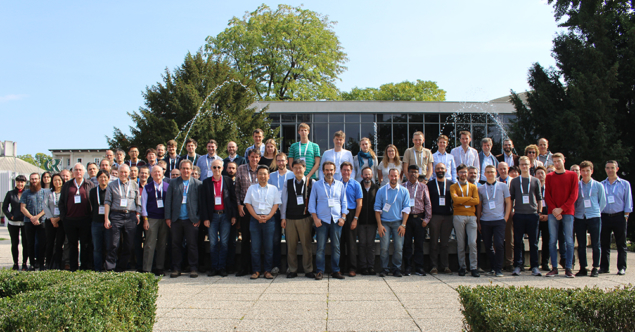
The international conference devoted to b-hadron physics at frontier machines, Beauty 2019, was held in Ljubljana, Slovenia, from 30 September to 4 October. The aims of the conference series are to review the latest results in heavy-flavour physics and discuss future directions. This year’s edition, the 18th in the series, attracted around 80 scientists and 65 invited talks, of which 13 were theory based.
The study of hadrons containing beauty quarks, and other heavy flavours, offers a powerful way to probe for physics beyond the Standard Model, as highlighted in the inspiring opening talk by Chris Quigg (Fermilab). In the last few years much attention has been focused on b-physics results that do not show perfect agreement with the predictions of the theory. In particular, studies by Belle, BaBar and LHCb of the processes B–→K–ℓ+ℓ– and B0 →K*ℓ+ℓ– (where ℓ± indicates a lepton) in specific kinematic regions have yielded different decay rates for muon pairs and electron pairs, apparently violating lepton universality. For both processes the significance of the effect is around 2.5σ. Popular models to explain this and related effects include leptoquarks and new Z’ bosons, however no firm conclusions can be drawn until more precise measurements are available, which should be the case when the next Beauty meeting occurs.
Indications that φs is nonzero are starting to emerge
The B system is an ideal laboratory for the study of CP violation, and recent results were presented by the LHC experiments for φs – the phase associated with time-dependent measurements of Bs meson decays to CP eigenstates. Indications that φs is nonzero are starting to emerge, which is remarkable given that its magnitude in the Standard Model is less than 0.1 radians. This is great encouragement for Run 3 of the LHC, and beyond.
Heavy-flavour experiments are also well suited to the study of hadron spectroscopy. Many very recent results were shown at the conference including the discovery of the X(3842), which is a charmonium resonance above the open charm threshold, and new excited resonances seen in the Λbππ final state, which help map out the relatively unexplored world of b-baryons. The ATLAS collaboration presented, for the first time, an analysis of Λb→J/ψpK decays in which a structure is observed that is compatible with that of the LHCb pentaquark discovery of 2015, providing the first confirmation by another experiment of these highly exotic states.
Beyond beauty
The Beauty conference welcomes reports on flavour studies beyond b-physics, and a highlight of the week was the first presentation at a conference of new results on the measurement of the branching ratio of the ultra-rare decay K+→π+νν̄, by the NA62 collaboration. The impressive background suppression that the experiment has achieved left the audience in no doubt as to the sensitivity of the result that can be expected when the full data set is accumulated and analysed. Comparing the measurement with the predicted branching fraction of ~10-10 will be a critical test of the Standard Model in the flavour domain.
Flavour physics has a bright future. Several talks presented the first signals and results from the early running of the Belle II experiment, and precise and exciting measurements can be expected when the next meeting in the Beauty series takes place. In parallel, studies with increasing sensitivity will continue to emerge from the LHC. The meeting was updated about progress on the LHCb upgrade, which is currently being installed ready for Run 3, and will allow for an order of magnitude increase in b-hadron samples. The conference was summarised by Patrick Koppenburg (Nikhef), who emphasised the enormous potential of b-hadron studies for uncovering signs of new physics beyond the Standard Model.
The next edition of Beauty will take place in Japan, hosted by Kavli IPMU, University of Tokyo, in autumn 2020.







